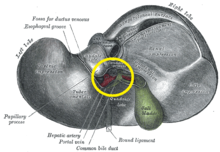Hilum (anatomy)

In human anatomy, the hilum (/ˈhaɪləm/; pl.: hila), sometimes formerly called a hilus (/ˈhaɪləs/; pl.: hili), is a depression or fissure where structures such as blood vessels and nerves enter an organ. Examples include:
- Hilum of kidney, admits the renal artery, vein, ureter, and nerves
- Splenic hilum, on the surface of the spleen, admits the splenic artery, vein, lymph vessels, and nerves
- Hilum of lung, a triangular depression where the structures which form the root of the lung enter and leave the viscus
- Hilum of lymph node, the portion of a lymph node where the efferent vessels exit
- Hilus of dentate gyrus, part of hippocampus that contains the mossy cells.

Index of articles associated with the same name
This article includes a list of related items that share the same name (or similar names). If an internal link incorrectly led you here, you may wish to change the link to point directly to the intended article.









